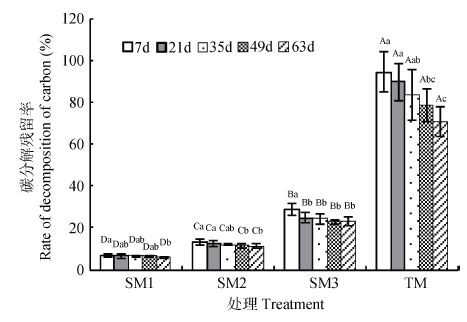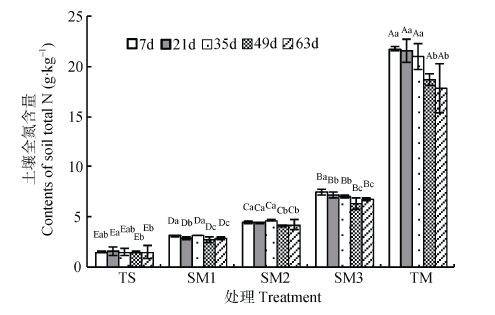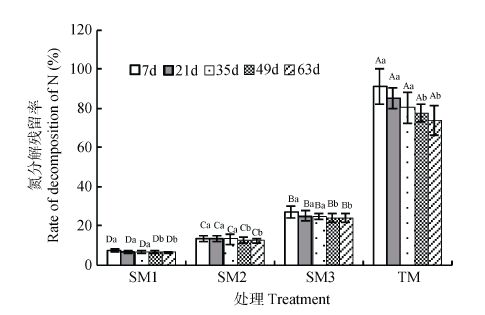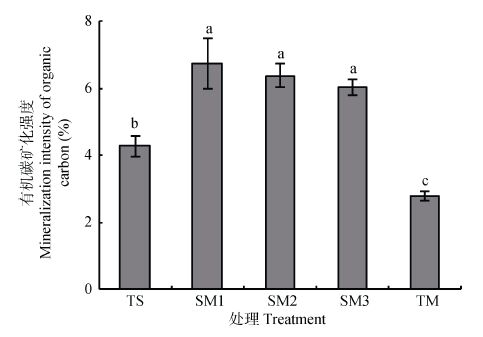Decomposition process and CO2 release characteristics of spent mushroom substrate in paddy soils
-
摘要: 菌渣是栽培食用菌后的下脚料,可作为有机肥再利用。本文通过实验室条件下培养不同比例的菌渣和稻田土壤混合物[不施用菌渣(TS),土壤与菌渣质量比为10:1(SM1)、5:1(SM2)和2:1(SM3),全部菌渣(TM)],研究不同处理有机碳和全氮的变化,探讨菌渣在稻田土壤中的分解过程,并分析CO2释放特征,为菌渣合理利用提供参考。结果表明,在相同培养时间,添加不同比例菌渣处理有机碳和氮含量均比TS处理高,其中TM处理的有机碳和全氮分别比TS处理提高了10.7倍和11.0倍。有机碳、氮含量的提高量主要依赖于菌渣的添加量。总体来说,各处理随培养时间的延长,由于碳氮的分解,有机碳、氮均有下降趋势;在35 d后TM处理有机碳氮下降较快。添加菌渣越多,有机碳残留率也越大。在培养63 d后,菌渣有机碳(YC)和氮(YN)的分解残留率与菌渣添加量(X)的关系式分别为:YC=71.26X-0.607 5,r21.000 0**和YN=74.039X-0.413 3,r20.999 9**。各处理土壤CO2释放速率均表现出先增后降然后趋于稳定趋势。菌渣用量越高,CO2释放速率越高,各处理在不同培养时间CO2释放速率均表现为TM > SM3 > SM2 > SM1 > TS。在第7 d时各处理CO2释放速率最高,在第14 d时渐渐处于平稳下降状态,培养35 d后,各处理土壤有机碳矿化强度很小,大部分有机碳被固定在土壤中,其中TM处理有机碳矿化强度最小。总之,还田菌渣越多,土壤中被固定的碳越多。Abstract: Spent mushroom substrate (SMS), leftovers after cultivation of mushroom, could serve as an organic fertilizer. In this study, different proportions of SMS were mixed into paddy rice soils under laboratory conditions to study the relationship between application of SMS and soil organic carbon decomposition, and further provide reference for the rational utilization of SMS for sustainable agricultural development. The study consisted of 5 treatments-no SMS application (TS), SMS mix with paddy rice soil at 10:1 (SM1), SMS mix with paddy rice soil at 5:1 (SM2), SMS mix with paddy rice soil at 2:1 (SM3) and sole SMS medium (TM). Then changes in soil organic carbon and nitrogen, decomposition process of organic carbon in soils and CO2 release characteristics in each treatment were determined. The results showed that soil organic carbon and total nitrogen contents under different proportions of SMS treatments were significantly higher than those under TS treatment for the same incubation time. Increase in organic carbon and total nitrogen contents mainly depended on the amount of SMS added to the soil. TM treatment showed the most obvious effect, which increased soil organic carbon and total nitrogen contents by 10.7 and 11.0 times, respectively. With increasing duration of incubation time, soil organic carbon and nitrogen decreased with the decomposition of carbon and nitrogen in all the treatments. Also organic carbon and nitrogen decreased relatively quickly under TM treatment after 35 d. The more SMS supply, the greater was the residue rate. After 63 d of cultivation, the relationships between the residue rates of organic carbon (YC) and nitrogen (YN) with the amount of SMS (X) were as follows:YC=71.26X-0.607 5 (r2=1.000 0**) and YN=74.039X-0.413 3 (r2=0.999 9**). The release rates of CO2 in all the treatments increased initially and then decreased before stabilization. The higher the amount of SMS, the higher was the release rate of CO2. On the 7th d after cultivation, the release rate of CO2 was highest in each treatment. After 14 d of cultivation, the release rate of CO2 in each treatment gradually decreased at a steady state. The order of the release rate of CO2 during the culturing period was TM > SM3 > SM2 > SM1 > TS. The cumulative release of CO2 showed a rapid growth in the early and slowed growth in the late periods. Mineralization intensity of soil organic carbon was very small after 35 d of cultivation and most of the organic carbon was fixed in the soil. In all the treatments, TM showed the lowest organic carbon mineralization intensity, indicating that SMS was beneficial for soil carbon sequestration.
-
-
图 1 添加不同比例菌渣后不同时间水稻土有机碳含量的变化
TS: 不施用蘑菇菌渣; SM1: 水稻土︰蘑菇菌渣=10︰1; SM2: 水稻土︰蘑菇菌渣=5︰1; SM3: 水稻土︰蘑菇菌渣=2︰1; TM: 全部为蘑菇菌渣。不同小写字母和大写字母分别表示同一处理不同时间段间和同一时间段不同处理间差异达显著水平(P< 0.05)。
Figure 1. Changes of organic carbon contents in paddy soil after adding different proportions of spent mushroom substrates for different times
TS: paddy soil without spent mushroom substrate; SM1: the ratio of paddy soil to spent mushroom substrate is 10︰1; SM2: the ratio of paddy soil to spent mushroom substrate is 5︰1; SM3: the ratio of paddy soil to spent mushroom substrate is 2︰1; TM: all is spent mushroom substrate. Different small letters and capital letters indicate significant difference among different times for the same treatment and different treatments at the same time,respectively,at 0.05 level.
图 2 添加不同比例菌渣后不同时间水稻土碳的分解残留率的变化
TS: 不施用蘑菇菌渣; SM1: 水稻土∶蘑菇菌渣=10︰1; SM2: 水稻土∶蘑菇菌渣=5︰1; SM3: 水稻土∶蘑菇菌渣=2︰1; TM: 全部为蘑菇菌渣。不同小写字母和大写字母分别表示同一处理不同时间段间和同一时间段不同处理间差异达显著水平(P<0.05)。
Figure 2. Changes of decomposition rates of carbon in paddy soil after adding different proportions of spent mushroom substrates for different times
TS: paddy soil without spent mushroom substrate; SM1: the ratio of paddy soil to spent mushroom substrate is 10︰1; SM2: the ratio of paddy soil to spent mushroom substrate is 5︰1; SM3: the ratio of paddy soil to spent mushroom substrate is 2︰1; TM: all is spent mushroom substrate. Different small letters and capital letters indicate significant difference among different times for the same treatment and different treatments at the same time,respectively,at 0.05 level.
图 3 添加不同比例菌渣后不同时间水稻土全氮含量的变化
TS: 不施用蘑菇菌渣; SM1: 水稻土︰蘑菇菌渣=10︰1; SM2:水稻土︰蘑菇菌渣=5︰1; SM3:水稻土:蘑菇菌渣=2︰1;TM: 全部为蘑菇菌渣。不同小写字母和大写字母分别表示同一处理不同时间段间和同一时间段不同处理间差异达显著水平(P<0.05)。
Figure 3. Changes of total nitrogen contents in paddy soil after adding different proportions of spent mushroom substrates for different times
TS: paddy soil without spent mushroom substrate; SM1: the ratio of paddy soil to spent mushroom substrate is 10︰1;SM2: the ratio of paddy soil to spent mushroom substrate is 5︰1; SM3:the ratio of paddy soil to spent mushroom substrate is 2︰1;TM: all is spent mushroom substrate. Different small letters and capital letters indicate significant difference among different times for the same treatment and different treatments at the same time,respectively,at 0.05 level.
图 4 添加不同比例菌渣后不同时间水稻土氮的分解残留率的变化
TS: 不施用蘑菇菌渣; SM1: 水稻土∶蘑菇菌渣=10︰1; SM2: 水稻土︰蘑菇菌渣=5︰1; SM3: 水稻土∶蘑菇菌渣=2︰1; TM: 全部为蘑菇菌渣。不同小写字母和大写字母分别表示同一处理不同时间段间和同一时间段不同处理间差异达显著水平(P<0.05)。
Figure 4. Changes of decomposition rates of nitrogen in paddy soil after adding different proportions of spent mushroom substrates for different times
TS: paddy soil without spent mushroom substrate; SM1: the ratio of paddy soil to spent mushroom substrate is 10︰1; SM2: the ratio of paddy soil to spent mushroom substrate is 5︰1; SM3: the ratio of paddy soil to spent mushroom substrate is 2︰1; TM: all is spent mushroom substrate. Different small letters and capital letters indicate significant difference among different times for the same treatment and different treatments at the same time,respectively,at 0.05 level.
图 5 添加不同比例菌渣后不同时间水稻土CO2释放速率(a)和累积释放量(b)的变化
TS:不施用蘑菇菌渣处理; SM1: 水稻土︰蘑菇菌渣=10︰1;SM2: 水稻土︰蘑菇菌渣=5︰1;SM3: 水稻土︰蘑菇菌渣= 2︰1;TM: 全部为蘑菇菌渣。
Figure 5. Changes of CO2 release rates (a) and cumulative release rates (b) in paddy soil after adding different proportions of spent mushroom substrates for different times
TS: paddy soil without spent mushroom substrate; SM1: the ratio of paddy soil to spent mushroom substrate is 10︰1;SM2: the ratio of paddy soil to spent mushroom substrate is 5︰1;SM3: the ratio of paddy soil to spent mushroom substrate is 2︰1;TM: all is spent mushroom substrate.
图 6 添加不同比例菌渣后不同时间水稻土的有机碳矿化强度
TS: 不施用蘑菇菌渣; SM1: 水稻土∶蘑菇菌渣=10︰1; SM2:水稻土︰蘑菇菌渣=5︰1; SM3:水稻土∶蘑菇菌渣=2︰1;TM: 全部为蘑菇菌渣。不同小写字母表示不同处理间差异达显著水平(P<0.05)。
Figure 6. Mineralization intensities of organic carbon in paddy soil after adding different proportions of spent mushroom substrates for different times
TS: paddy soil without spent mushroom substrate; SM1: the ratio of paddy soil to spent mushroom substrate is 10∶1;SM2: the ratio of paddy soil to spent mushroom substrate is 5︰1;SM3: the ratio of paddy soil to spent mushroom substrate is 2︰1;TM: all is spent mushroom substrate. Different small letters indicate significant difference among treatments at 0.05 level.
-
[1] 翁伯琦, 廖建华, 罗涛, 等. 发展农田秸秆菌业的技术集成与资源循环利用管理对策[J]. 中国生态农业学报, 2009, 17(5):1007-1011 doi: 10.3724/SP.J.1011.2009.01007 Weng B Q, Liao J H, Luo T, et al. Integrative technology of straw-edible fungi industry and management countermeasure for resource recycling utilization[J]. Chinese Journal of Eco-Agriculture, 2009, 17(5):1007-1011 doi: 10.3724/SP.J.1011.2009.01007
[2] Stewart D P C, Cameron K C, Cornforth I S. Effects of spent mushroom substrate on soil chemical conditions and plant growth in an intensive horticultural system:A comparison with inorganic fertiliser[J]. Australian Journal of Soil Research, 1998, 36(2):185-198 doi: 10.1071/S97076
[3] Phan C W, Sabaratnam V. Potential uses of spent mushroom substrate and its associated lignocellulosic enzymes[J]. Applied Microbiology and Biotechnology, 2012, 96(4):863-873 doi: 10.1007/s00253-012-4446-9
[4] Wang S X, Xu F, Li Z M, et al. The spent mushroom substrates of Hypsizigus marmoreus can be an effective component for growing the oyster mushroom Pleurotus ostreatus[J]. Scientia Horticulturae, 2015, 186:217-222 doi: 10.1016/j.scienta.2015.02.028
[5] Kalembasa D, Becher M. Speciation of carbon and selected metals in spent mushroom substrates[J]. Journal of Elementology, 2012, 17(3):409-419
[6] Adedokun O M, Orluchukwu J A. Pineapple:Organic production on soil amended with spent mushroom substrate[J]. Agriculture and Biology Journal of North America, 2013, 4(6):590-593
[7] Medina E, Paredes C, Pérez-Murcia M D, et al. Spent mushroom substrates as component of growing media for germination and growth of horticultural plants[J]. Bioresource Technology, 2009, 100(18):4227-4232 doi: 10.1016/j.biortech.2009.03.055
[8] Sharma H S S, Furlan A, Lyons G. Comparative assessment of chelated spent mushroom substrates as casing material for the production of Agaricus bisporus[J]. Applied Microbiology and Biotechnology, 1999, 52(3):366-372 doi: 10.1007/s002530051533
[9] Zhou Q, Gong W Q, Li Y B, et al. Biosorption of Methylene Blue onto spent corncob substrate:Kinetics, equilibrium and thermodynamic studies[J]. Water Science and Technology, 2011, 63(12):2775-2780 doi: 10.2166/wst.2011.542
[10] Ribas L C C, de Mendonça M M, Camelini C M, et al. Use of spent mushroom substrates from Agaricus subrufescens (syn. A. blazei, A. brasiliensis) and Lentinula edodes productions in the enrichment of a soil-based potting media for lettuce (Lactuca sativa) cultivation:Growth promotion and soil bioremediation[J]. Bioresource Technology, 2009, 100(20):4750-4757 doi: 10.1016/j.biortech.2008.10.059
[11] Tam N V, Wang C H. Use of spent mushroom substrate and manure compost for honeydew melon seedlings[J]. Journal of Plant Growth Regulation, 2015, 34(2):417-424 doi: 10.1007/s00344-015-9478-9
[12] Peregrina F, Larrieta C, Colina M, et al. Spent mushroom substrates influence soil quality and nitrogen availability in a semiarid vineyard soil[J]. Soil Science Society of America Journal, 2012, 76(5):1655-1666 doi: 10.2136/sssaj2012.0018
[13] René M, Rémi C. Long-term additions of organic amendments in a Loire valley vineyard. Ⅰ. Effects on properties of a calcareous sandy soil[J]. American Journal of Enology and Viticulture, 2008, 59(4):353-363
[14] 栗方亮, 王煌平, 张青, 等. 稻田施用菌渣土壤团聚体的组成及评价[J]. 生态与农村环境学报, 2015, 31(3):340-345 http://www.cnki.com.cn/Article/CJFDTOTAL-NCST201503012.htm Li F L, Wang H P, Zhang Q, et al. Effect of application of mushroom residue on composition of soil aggregates in paddy field and its evaluation[J]. Journal of Ecology and Rural Environment, 2015, 31(3):340-345 http://www.cnki.com.cn/Article/CJFDTOTAL-NCST201503012.htm
[15] Zhang Y, Li C S, Zhou X J, et al. A simulation model linking crop growth and soil biogeochemistry for sustainable agriculture[J]. Ecological Modelling, 2002, 151(1):75-108 doi: 10.1016/S0304-3800(01)00527-0
[16] Carlisle E A, Steenwerth K L, Smart D R. Effects of land use on soil respiration:Conversion of oak woodlands to vineyards[J]. Journal of Environmental Quality, 2006, 35(4):1396-1404 doi: 10.2134/jeq2005.0155
[17] Ding W X, Meng L, Yin Y F, et al. CO2 emission in an intensively cultivated loam as affected by long-term application of organic manure and nitrogen fertilizer[J]. Soil Biology and Biochemistry, 2007, 39(2):669-679 doi: 10.1016/j.soilbio.2006.09.024
[18] Singh K P, Ghoshal N, Singh S. Soil carbon dioxide flux, carbon sequestration and crop productivity in a tropical dryland agroecosystem:Influence of organic inputs of varying resource quality[J]. Applied Soil Ecology, 2009, 42(3):243-253 doi: 10.1016/j.apsoil.2009.04.005
[19] Priha O, Smolande A. Fumigation-extraction and substrateinduced respiration derived microbial biomass C, and respiration rate in limed soil of scots pine sapling stands[J]. Biology and Fertility of Soils, 1994, 17(4):301-308 doi: 10.1007/BF00383986
[20] Xiao Y, Xie G D, Lu C X, et al. The value of gas exchange as a service by rice paddies in suburban Shanghai, PR China[J]. Agriculture, Ecosystems & Environment, 2005, 109(3/4):273-283
[21] Zheng J F, Zhang X H, Li L Q, et al. Effect of long-term fertilization on C mineralization and production of CH4 and CO2 under anaerobic incubation from bulk samples and particle size fractions of a typical paddy soil[J]. Agriculture, Ecosystems & Environment, 2007, 120(2/4):129-138
[22] Mariscal-Sancho I, Santano J, Mendiola M Á, et al. Carbon dioxide emission rates and β-Glucosidase activity in Mediterranean ultisols under different soil management[J]. Soil Science, 2010, 175(9):453-460 doi: 10.1097/SS.0b013e3181f51704
[23] 强学彩, 袁红莉, 高旺盛. 秸秆还田量对土壤CO2释放和土壤微生物量的影响[J]. 应用生态学报, 2004, 15(3):469-472 Qiang X C, Yuan H L, Gao W S. Effect of crop-residue incorporation on soil CO2 emission and soil microbial biomass[J]. Chinese Journal of Applied Ecology, 2004, 15(3):469-472
[24] 李传章. 不同有机肥分解转化特性及土壤培肥效果的研究[D]. 南宁:广西大学, 2012 Li C Z. The research on decomposition properties of different organic fertilizer and effect of increasing soil fertility[D]. Nanning:Guangxi University, 2012
[25] 严红, 魏湜, 张雷, 等. 有机物料施用量对土壤CO2排放速率的影响[J]. 大连大学学报, 2005, 26(4):46-50 Yan H, Wei S, Zhang L, et al. Influence of organic material amount on CO2 released rate from the soil[J]. Journal of Dalian University, 2005, 26(4):46-50
[26] Medina E, Paredes C, Bustamante M A, et al. Relationships between soil physico-chemical, chemical and biological properties in a soil amended with spent mushroom substrate[J]. Geoderma, 2012, 173-174:152-161 doi: 10.1016/j.geoderma.2011.12.011
[27] Steenwerth K L, Pierce D L, Carlisle E A, et al. A vineyard agroecosystem:Disturbance and precipitation affect soil respiration under Mediterranean conditions[J]. Soil Science Society of America Journal, 2010, 74(1):231-239 doi: 10.2136/sssaj2008.0346
[28] 迟凤琴, 匡恩俊, 宿庆瑞, 等. 不同还田方式下有机物料有机碳分解规律研究[J]. 东北农业大学学报, 2010, 41(2):60-65 http://www.cnki.com.cn/Article/CJFDTOTAL-DBDN201002018.htm Chi F Q, Kuang E J, Su Q R, et al. Study on organic carbon decomposition regularity of organic materials in different incorporation methods[J]. Journal of Northeast Agricultural University, 2010, 41(2):60-65 http://www.cnki.com.cn/Article/CJFDTOTAL-DBDN201002018.htm
[29] Galantini J, Rosell R. Long-term fertilization effects on soil organic matter quality and dynamics under different production systems in semiarid Pampean soils[J]. Soil and Tillage Research, 2006, 87(1):72-79 doi: 10.1016/j.still.2005.02.032
[30] 李忠佩, 吴晓晨, 陈碧云. 不同利用方式下土壤有机碳转化及微生物群落功能多样性变化[J]. 中国农业科学, 2007, 40(8):1712-1721 http://www.cnki.com.cn/Article/CJFDTOTAL-ZNYK200708017.htm Li Z P, Wu X C, Chen B Y. Changes in transformation of soil organic carbon and functional diversity of soil microbial community under different land use patterns[J]. Scientia Agricultura Sinica, 2007, 40(8):1712-1721 http://www.cnki.com.cn/Article/CJFDTOTAL-ZNYK200708017.htm
[31] 鲁如坤. 土壤农业化学分析方法[M]. 北京:中国农业科技出版社, 2000 Lu R K. Analytical Methods for Soil and Agricultural Chemistry[M]. Beijing:China Agricultural Science and Technology Press, 2000
[32] 柳敏, 张璐, 宇万太, 等. 有机物料中有机碳和有机氮的分解进程及分解残留率[J]. 应用生态学报, 2007, 18(11):2503-2506 http://www.cnki.com.cn/Article/CJFDTOTAL-YYSB200711020.htm Liu M, Zhang L, Yu W T, et al. Decomposition process and residual rate of organic materials C and N in soils[J]. Chinese Journal of Applied Ecology, 2007, 18(11):2503-2506 http://www.cnki.com.cn/Article/CJFDTOTAL-YYSB200711020.htm
[33] 娄燕宏, 诸葛玉平, 魏猛, 等. 外源有机物料对土壤氮矿化的影响[J]. 土壤通报, 2009, 40(2):315-320 http://www.cnki.com.cn/Article/CJFDTOTAL-TRTB200902028.htm Lou Y H, Zhuge Y P, Wei M, et al. Effect of extraneous organic materials on the mineralization of nitrogen in soil[J]. Chinese Journal of Soil Science, 2009, 40(2):315-320 http://www.cnki.com.cn/Article/CJFDTOTAL-TRTB200902028.htm
[34] 李顺姬, 邱莉萍, 张兴昌. 黄土高原土壤有机碳矿化及其与土壤理化性质的关系[J]. 生态学报, 2010, 30(5):1217-1226 http://www.cnki.com.cn/Article/CJFDTOTAL-STXB201005014.htm Li S J, Qiu L P, Zhang X C. Mineralization of soil organic carbon and its relations with soil physical and chemical properties on the Loess Plateau[J]. Acta Ecologica Sinica, 2010, 30(5):1217-1226 http://www.cnki.com.cn/Article/CJFDTOTAL-STXB201005014.htm
[35] 张杰, 黄金生, 刘佳, 等. 秸秆、木质素及其生物炭对潮土CO2释放及有机碳含量的影响[J]. 农业环境科学学报, 2015, 34(2):401-408 Zhang J, Huang J S, Liu J, et al. Carbon dioxide emissions and organic carbon contents of fluvo-aquic soil as influenced by straw and lignin and their biochars[J]. Journal of Agro-Environment Science, 2015, 34(2):401-408
[36] 任秋容. 菌渣还田腐解特性及其对土壤养分和作物产量的影响研究[D]. 雅安:四川农业大学, 2009 Ren Q R. Study on decomposition characteristics of mushroom residue returning to soil and its effect on soil nutrient and crop yield[D]. Ya'an:Sichuan Agricultural University, 2009
[37] 李忠佩, 张桃林, 陈碧云. 可溶性有机碳的含量动态及其与土壤有机碳矿化的关系[J]. 土壤学报, 2004, 41(4):544-552 http://www.cnki.com.cn/Article/CJFDTOTAL-TRXB200404007.htm Li Z P, Zhang T L, Chen B Y. Dynamics of soluble organic carbon and its relation to mineralization of soil organic carbon[J]. Acta Pedologica Sinica, 2004, 41(4):544-552 http://www.cnki.com.cn/Article/CJFDTOTAL-TRXB200404007.htm
[38] 戴万宏, 刘军, 王益权, 等. 不同培肥措施下土壤CO2释放及其动力学研究[J]. 植物营养与肥料学报, 2002, 8(3):292-297 Dai W H, Liu J, Wang Y Q, et al. Study on CO2 emissions and its kinetics of soils with different fertilization systems[J]. Plant Nutrition and Fertilizer Science, 2002, 8(3):292-297
[39] 李梦雅, 王伯仁, 徐明岗, 等. 长期施肥对红壤有机碳矿化及微生物活性的影响[J]. 核农学报, 2009, 23(6):1043-1049 http://www.cnki.com.cn/Article/CJFDTOTAL-HNXB200906025.htm Li M Y, Wang B R, Xu M G, et al. Effect of long-term fertilization on mineralization of organic carbon and microbial activity in red soil[J]. Journal of Nuclear Agricultural Sciences, 2009, 23(6):1043-1049 http://www.cnki.com.cn/Article/CJFDTOTAL-HNXB200906025.htm
[40] Kemmitt S J, Lanyon C V, Waite I S, et al. Mineralization of native soil organic matter is not regulated by the size, activity or composition of the soil microbial biomass-a new perspective[J]. Soil Biology and Biochemistry, 2008, 40(1):61-73 doi: 10.1016/j.soilbio.2007.06.021
[41] West T O, Marland G. A synthesis of carbon sequestration, carbon emissions, and net carbon flux in agriculture:Comparing tillage practices in the United States[J]. Agriculture, Ecosystems & Environment, 2002, 91(1/2/3):217-232
[42] Mohamad R S, Verrastro V, Bitar L A, et al. Effect of different agricultural practices on carbon emission and carbon stock in organic and conventional olive systems[J]. Soil Research, 2016, 54(2):173-181 doi: 10.1071/SR14343



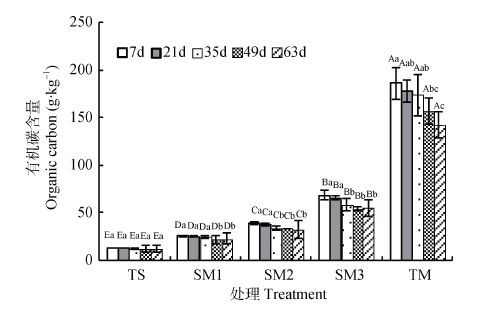
 下载:
下载:
